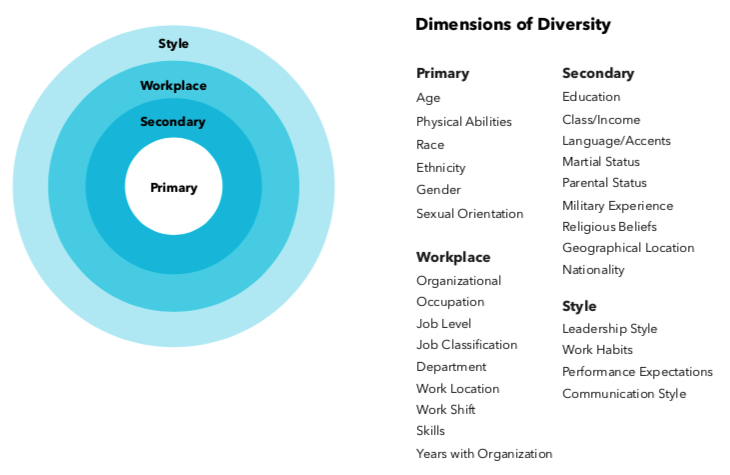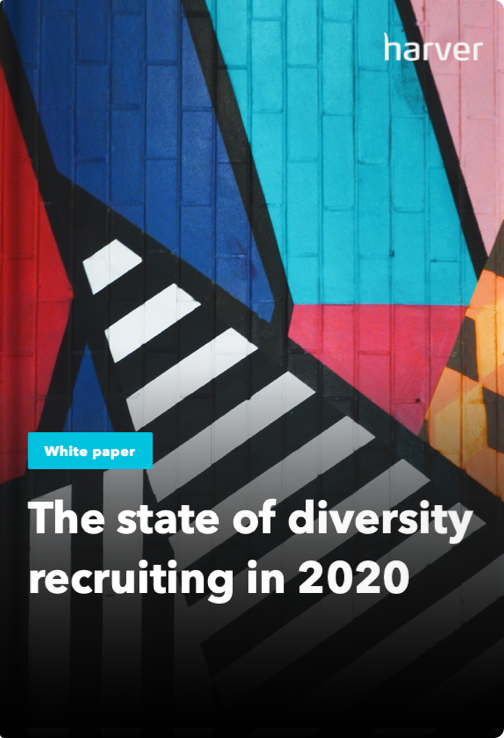In all settings, diversity is as beneficial as it is necessary. Although the research on the topic is monumental, you don’t need to sift through piles of data, studies, and research papers to know this.
Retail workers interact with customers face-to-face every day. Then, when you consider your workforce provides a physical indication of your company’s values, representation becomes all the more essential.
We live in a diverse world. We’re regularly surrounded by people of different ethnicities, ages, disabilities, sexual orientations, and more. As such, all workforces need to be just as inclusive and representative of broader society.
Consequently, diversity and inclusion shouldn’t be treated like other HR trends. Instead, they’re business imperatives, and one glance at the retail sector tells us we still have work to do.
What's in?
The retail workforce is becoming more diverse
In the US and Europe, retail’s response to tackling diversity and inclusion is lagging.
The UK’s retail sector makes up 10% of the country’s total workforce, and data shows that the industry has the second-highest number of non-white workers after health and social work. But despite that, most only work on the shop floor level, and concerningly, one in four retail workers surveyed from ethnic minorities report having witnessed or experienced racism in the workplace.
Ethnicity isn’t the only problem either. It’s gender too. In the past year alone, the number of female retail leaders in the Retail 100 dropped from 23 to 20. Research also discovered that 13% of female employees have experienced or witnessed sexual harassment at work, and 14% have encountered gender discrimination.
For the retail sector to become more inclusive, employers should focus on other areas of diversity too. For instance, only 27% of retailers reported having at least one visible LGBTQ+ leader within the top two executive management levels. Plus, just 7% reported having at least one disabled leader within these management tiers.
Compared to the rest of Europe, the UK is falling behind. According to the Financial Times, France’s retail company Biocoop is Europe’s most diverse and inclusive company, and Netherlands’ retail giant IKEA also makes it into the Top 10.
In the US, social movements like Black Lives Matter created waves in corporate America, drawing our attention to the inequalities in workforces across the country. Racial representation in various sectors, specifically retail, has become a key discussion point, and disparities have become glaringly apparent.
Like Europe, most top-level executives are white, with only 14% being minorities. Across the UK, the US, and the rest of Europe, there are 337 executive directors in retail, yet only 70 are female, and just 17 are BAME. According to research by Mckinsey, more than 60% of black consumers report facing racial discrimination in retail stores, and 50% have faced discrimination while making a purchase.
However, since 2010 the percentage of employees of color in retail has increased, and if the trend continues, the country could see a much more diverse workforce in the coming years.
The state of diversity recruiting in 2020
Retail industry inclusion still has a long way to go
More retailers than ever before are making commitments to improve diversity and inclusion in their workplaces. For example, the UK’s John Lewis Partnership announced plans to become the UK’s most inclusive business for staff and customers by implementing more support like equally paid parental leave.
Its work in its internal Black Partner Advisory Group has also been praised. This sort of action is becoming more and more commonplace for retailers and is undoubtedly a step in the right direction.
But back in the boardroom, minorities are still underrepresented. In fact, as many as 78% of employees who responded to a Harvard Business Review (HBR) said they work at organizations that lack diversity in leadership positions. This percentage is monumental, particularly in an age where championing diversity and inclusion is of such importance.
Inadequate D&I measures can diminish feelings of inclusion in the workplace and hamper productivity and innovation. According to a study by Harvard Business Review, companies with higher-than-average diversity enjoyed 19% higher innovation revenues. Also, a 2014 Gallup poll across 800 units from two retail companies showed that gender-diverse teams had a 14% higher average comparable revenue than less diverse business units.
Despite 84% of retailers stating that diversity and inclusion are top priorities, less than half (49%) of retail employees agree that employers take it seriously. The statistics mentioned above on UK, US, and European D&I in retail suggest that there’s still a long way to go if employees are to feel genuinely valued and represented in the workforce.
To build a strong, effective, and content workforce, promoting diversity and inclusion is imperative. But what steps should employers take to successfully implement D&I measures?
Improving D&I starts with measuring the efforts
To build an inclusive retail culture, workplaces should focus on measuring diversity and inclusion. But, to do that, we need to define what diversity and inclusion actually are.
In short, diversity refers to an individual’s traits and characteristics; while these are easy to measure, inclusion is mainly invisible. In contrast, inclusion is the behavior that makes the team feel welcome. As such, to measure inclusion, workplaces have to go beyond just assessing data and analytics.
Measurable diversity KPIs include:
Primary:
This refers to ‘basic’ characteristics like age, race, gender, and sexual orientation.Secondary:
This includes education, marital status, parental status, and religious beliefs.Workplace:
This is the individual’s job level, work shift, and years spent with the organization.Style:
These are mainly work habits, leadership style, and communication style.

Today’s consumer is more diverse than ever before, and in the coming years, Gen Z will be the generation with the most purchasing power in the world. They’ll soon set the trends and determine the future success of thousands of businesses.
As many as 50% of the total US population are Gen-Zer’s or millennials and comprise a staggering 60% of the US minority population. In light of that, it’s no wonder that diversity and representation are essential to them. As such, they demand transparency, vulnerability, and honesty from their brands. For instance, more than 75% of Gen Z consumers will end relationships with companies they perceive as racist or homophobic.
The bottom line: Not only are diversity and inclusion necessary for developing a more tolerant world, but they’re also necessary for the future of businesses too. Without more concrete commitments from companies to improve D&I in the workplace, companies could suffer massive financial repercussions and tarnish their reputations.
Like what you see?
Don’t miss out. Subscribe to our quarterly digest to get the latest TA and TM resources delivered right to your inbox.
5 tactics retailers can use to promote D&I in the workplace
To build a diverse retail workforce, you’ll need to develop the right tactics to make your hiring more varied. Employers should first look at their metrics and remember that diversity also includes age and social mobility, two groups that often get missed out of D&I measures.
By looking at the diversity of your existing employees, retailers can begin to understand which demographics lack representation and start to look at ways to improve their company culture.
Below is a list of tactics you can use to increase diversity in the workplace and build a more inclusive retail culture.
1. Increase diversity during hiring
Use a data-driven approach that emphasizes skills and characteristics over resumes, gender, and candidate names. Scientifically validated pre-employment assessments that are designed for volume hiring are great for massively reducing unconscious bias by prioritizing skills, characteristics, and personality traits over other factors like education, race, sexuality, age, or disability.
For example, one of our clients in the auditing industry increased its number of female hires by 44% after implementing the Harver volume hiring solution.
2. Promote pay equity
Are you aware of any pay gaps across your team? If so, are the reasons for these justified? Organizations should attempt to leverage analytics to identify whether employees in similar roles are paid unequally. Employers are better positioned to address underlying issues by recognizing pay disparities and nipping any accidental discrimination in the bud.
3. Diversity training
Improving diversity training in the workplace may seem like a no-brainer. Still, it will fail to benefit your business if it’s not implemented correctly. Successful diversity training should focus on creating shared company and employee goals, confronting unconscious bias, and improving feelings of inclusion.
The methods used to execute diversity training should also be chosen wisely; training methods are just as important as the messages you’re delivering to employees. Gamification is a commonly used method; this brings groups together to solve a problem or reach a goal. Microlearning is also popular – with microlearning, training is delivered in small bites rather than hours at a time.
When training is provided as and when employees need it rather than all in one go, it makes employees more likely to engage and digest the info you’re presenting them.
4. Facilitate feedback
One of the best ways to improve diversity and inclusion in any workforce is to get the perspective of your workforce. You could distribute surveys amongst employees that allow for anonymous feedback; this encourages people to talk more freely about their concerns and, again, helps to eliminate bias.
This is useful for identifying and solving various diversity issues, both small and large, and works wonders for contributing to a greater sense of inclusion. After all, when employees feel like they’re being heard and respected, they’re more likely to feel like valued workforce members.
5. Track your progress
The only real way to determine success (or failure) is to measure your progress. Cultural shifts can take time, and you shouldn’t expect diversity and inclusion to improve overnight. Instead, once you’ve successfully implemented a range of strategies, monitor the effects and set benchmarks to measure success.
This could be keeping an eye on employee feedback or monitoring the methods used in your hiring process, and seeing if they’re actively improving the diversity of your workforce. We’ve detailed the topic in the article below.
The bottom line
As we’ve seen, D&I isn’t just beneficial for your workforce; it’s healthy for business too. Often, companies that don’t adapt don’t survive. In today’s world, employees and consumers are demanding more transparency and identifiable change. The world is in the midst of one of the biggest equity and justice movements it’s ever seen.
Although small retailers can improve D&I on the ground (and it’s easy to do), the most significant changes need to come from higher up the chain. When we see more minority representation at the top, the positive effects trickle downwards, particularly when it comes to inclusion.
With so many consumers willing to turn away from valued brands who lack D&I and authenticity, the time is now to improve diversity and recruitment in retail and make it one of the leading sectors for change. If you’d like to see how Harver can help, you can book a demo below.
Ready to transform your hiring process?


